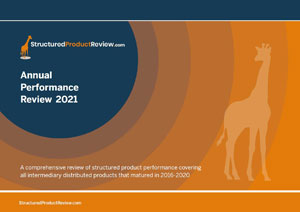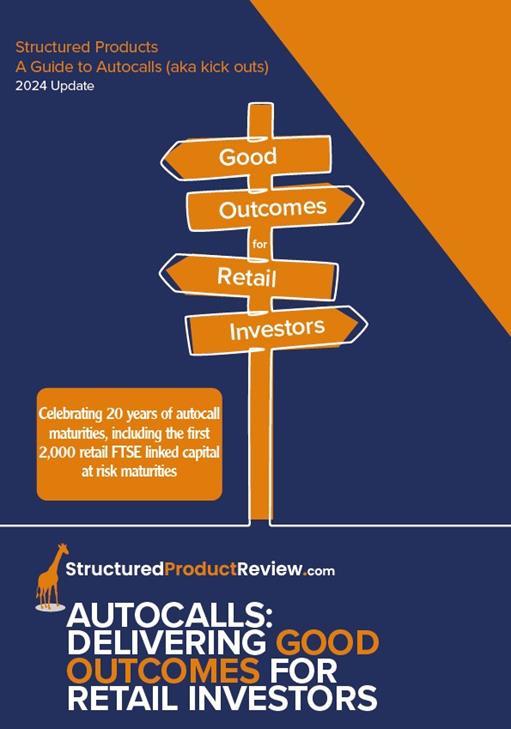13/12/2023
For most investments which offer regular trading, such as collective investments, some form of volatility measure is used as a measure of risk. This measures how much a price varies from its long-term average and is relevant as an investor could possibly buy in at a high level and sell when it is low. The SRI score shown on Key Information Documents (KIDs) is one such measure, fitting the volatility of the investment in question into one of seven bands.
As investments with defined outcomes intra-term volatility measures for measuring risk are significantly less appropriate for Structured Products. Although providers publish regular pricing to show the value the bank would pay on an early surrender of a structure this is largely irrelevant to investors. With new issue retail structures, all investments in a particular plan start on the same day, and are designed to be held until a triggered maturity, when all investors exit on the same terms with a pre-defined outcome. The intra-term pricing of a structure does not affect the return an investor will get.
For deposit based and capital protected structured plans, although the return is usually based on movement in an underlying index, the capital will be returned in full at maturity with the only exception being the counterparty default. Provided the issuer is a significant counterparty with a strong credit rating or if lower, the deposit has the benefit of FSCS protection, capital should be returned in full at maturity other than in exceptional circumstances.
For other shapes, we need to additionally consider the risk of losing capital at maturity from market / underlying measure movements. We accept that past performance is not an indicator of future performance however, due to the defined outcome nature of Structured Products, we can back-test the likelihood of different ‘shapes’ paying out with a positive return, just returning capital, or giving rise to a loss.
Such back-testing provides an indication of probability of outcomes which should be coupled with a common-sense approach to further mitigate foreseeable potential harm.
The table below shows the December 2023 back-test results which have changed very little over the years. With the exception of the final entry, these are based on the FTSE 100 index as the underlying, which gives data back to the beginning of 1984. The final entry is reliant on the FTSE 100 and EuroStoxx 50 indices. All are for an 8-year autocall contract with a 65% end of term barrier with annual maturity observations, with the first being on the second anniversary.
|
Payout levels |
Positive Return |
Capital Only |
Loss |
|
“Step-down” NC/100/100/95/95/95/90/90 |
99.99% |
0.01% |
0.00% |
|
“Defensive” 95% of strike level throughout |
99.48% |
0.52% |
0.00% |
|
“At the money” Higher than strike level |
97.84% |
2.10% |
0.06% |
|
“Hurdle” Must be at least 5% higher than strike level |
93.74% |
6.08% |
0.18% |
|
“Dual index At the money” Both indices must be higher than strike level |
88.65% |
8.96% |
2.39% |
As at 6th December 2023
The results show that there has never been a day in history where the ‘step-down’ shape (where the index level required to give a positive return reduces over time), would have given rise to a loss, and only one day where the strategy could have begun and returned capital only.
The ‘95% throughout’ shape means the index can be down by up to 5% on any anniversary and still give rise to a positive outcome. Again, the back-test shows that there would never have been a day in the history of the FTSE 100 index where this strategy would have led to a loss of capital, although there were fifty-one days (out of a possible 9,843) which would have returned capital only.
The ‘at the money’ shape requires the index to be the same or higher than its starting level to give a positive return. There have been occasions in history where this shape could have given rise to a loss, but only six days, or 0.06% of all possible days which have produced a result so far. There are a further 204 days, or 2.10%, which would have returned capital only. We think this is a demonstrably low risk when considering the risk of loss to invested capital at maturity.
With the hurdle contract, this requires the index to be up by 5% from its starting level to produce a positive return. As expected, this makes it harder for this type of shape to produce a positive return, and is more likely to return capital only or produce a loss than the first three. The probability of a negative return is still low, however, with 17 days, or 0.18% of all possible observations. There is a larger probability of only returning capital with 564 possible days, or 6.08%.
The final shape, which relies on two indices being higher than their starting levels, does give more opportunities for a negative return. Although still small, relative to the other shapes it is higher.
The back testing methodology naturally reflects actual outcomes where for example, no FTSE 100 linked autocall contract has matured with a loss and only thirteen out of 1,750 to mature to date returned capital only. In practice therefore the volatility of maturity outcomes is extremely low with almost all single index autocalls delivering their pre-defined returns.
That’s not to say that risks should ever be underplayed, not least because there will undoubtably be black swan events in the future that could change the picture. However, given the substantial lack of volatility of actual and projected outcomes of structured investments, is it time to revisit the use of SRI scores, which assess theoretical and largely irrelevant surrender price volatility which has little relevance to an investor in a solution designed to be held until a triggered maturity when based on back-tested data a defined outcome will likely be delivered?
Structured investments put capital at risk.
Also in this section
- How old is too old? Are structured products to die for?
- Product focus - October 2024
- Q3 2024 Issuance
- Q3 2024 maturity results
- A share of spread bets on steroids?
- Product focus - September 2024
- Maturities of the month - August 2024
- Right on time
- Product focus - August 2024
- Keep calm and zoom out
- 2,000 and counting
- Q2 2024 maturity results
- 20 years of autocall maturities
- Product focus - June 2024
- Fixed income or interest?
- Maturities of the month - May 2024
- The barrier debate - revisited
- Product focus - April 2024
- Maturities of the month - April 2024
- Time to call
- I don't believe markets are ever too high for Structured products!
- Notes on counterparty exposure
- Return of Nikkei
- Q1 2024 issuance
- Q1 2024 maturity results
- Structured Products – AAAAAGH!
- Hop in CIBC
- Re-enter Santander
- How to build a financial fortune - revisited
- Issuance in 2023
- Where's the risk?
- Questionable offerings
- Challenging the case against structured products - 'Loss of dividends'
- Navigating the investment landscape
- Challenging the case against structured products - Counterparty risk
- 6-year autocalls approaching final destination
- 1,750 FTSE capital at risk autocall maturities
- The leopard that changed her spots
- Q3 2023
- Challenging the case against structured products - Keydata
- Dilemmas for UK IFA's and the unique role of Structured Products
- 'High charges'
- Precipice bonds
- Intro
- FTSE 100 Contingent Income
- Indexing the indices
- Something different
- Investing through volatility
- 100 10:10s
- The best or worst?
- The 10%/25% 'Rule' that never was
- Structured products and the yield curve
- Fixed income: Capital at risk?
- Prospects for UK inflation - and fun with A.I!
- The Barrier Debate
- More Deposits for now
- Last of the Americans
- What if?
- Time heals all wounds, we hope...
- How to diversify portfolios using structured products?
- The Proof Is In The Pudding...
- Debunking Structured Misconceptions
- 1,500 FTSE Capital-at-Risk Autocall Maturities
- Q3 2022 Maturity Results
- What do we prefer?
- Deposits vs Capital ‘Protected’
- There’s time yet…
- Where did you invest your clients?
- A Six-Month Reflection
- Return of the Rev Con
- Happy 2nd Birthday FTSE CSDI
- Q2 2022 Maturity Results
- The best and worst yet still the best
- Critique my Suitability - Mariana 10:10 Plan June 2022 (Option 2)
- 10/10 for 55 10:10’s
- Q1 2022 Maturity Results
- 'How to build a financial fortune': a follow up
- Critique my Suitability - Mariana 10:10 Plan April 2022 (Option 2)
- 2021 Capital-at-Risk Autocall Maturity Review
- An unwelcome return...
- CSDI's First Birthday
- Bon Anniversaire
- Introducing the FTSE Custom 100 Synthetic 3.5% Fixed Dividend Index
- Q3 2021 Maturity Results
- Critique my Suitability - Mariana 10:10 Plan October 2021 (Option 2)
- Blurring the lines...
- Beware of false knowledge; it is more dangerous than ignorance
- Good news, bad news...
- Certainty is Certainly a Benefit
- Critique my Suitability - Mariana 10:10 Plan September 2021 (Option 2)
- A Twenty-Year Progression
- Q2 2021 Maturity Results
- Nine 8:8s Post Positive Returns in Falling Markets
- Critique my Suitability
- Q1 2021 Maturity Results
- Morgan Stanley’s Marvelous Maturity Medley
Current Products
We review the UK's retail structured investment sector, providing pertinent support for Professional Advisers and relevant research tools.
View all ⟶


